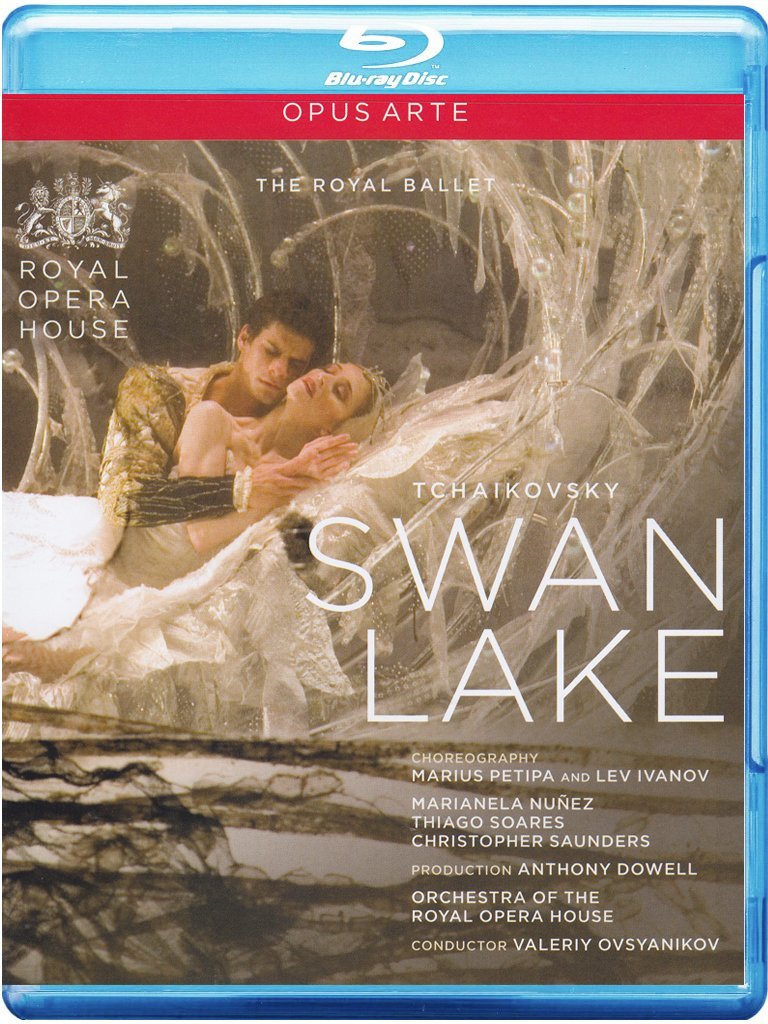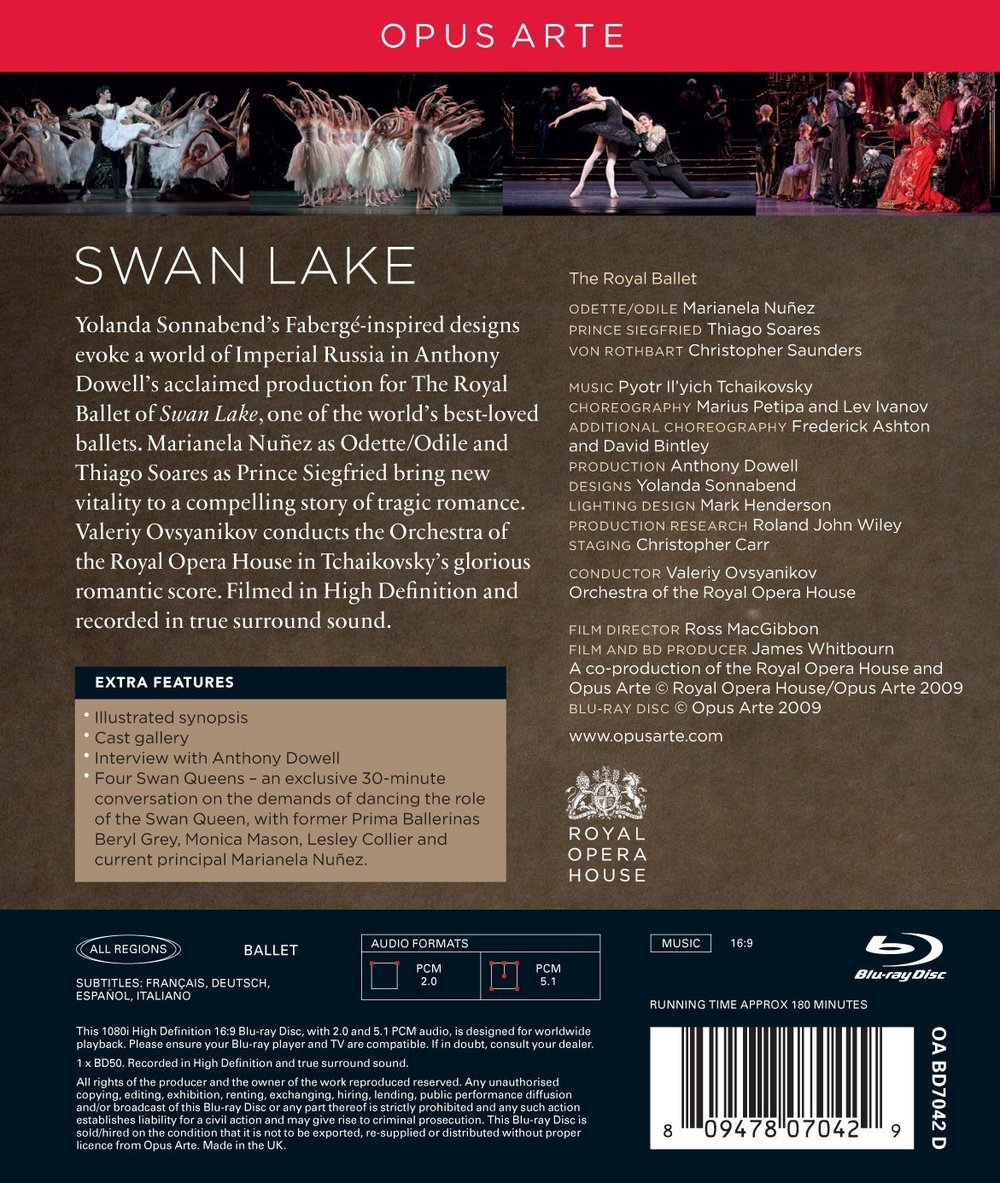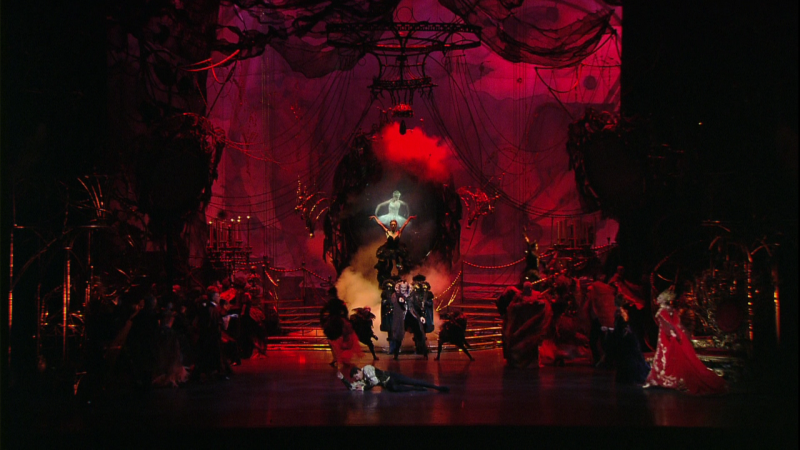

Swan Lake ballet. Music by Tchaikovsky. Book by V. P. Begitchev and Vasily Geltzer. Choreography by Marius Petipa, Lev Ivanov, Frederick Ashton, and David Bintley. Directed 2009 by Anthony Dowell at the Royal Opera House Ballet. Stars Marianela Nuñez (Odette/Odile), Thiago Soares (Prince Siegfried), Christopher Saunders (Von Rothbart), Elizabeth McGorian (Queen), Alastair Marriott (Tutor), David Pickering (Benno), Gary Avis (Lord Chamberlain). Other dancers are: Laura Morera, Yuhui Choe, Steven McRae (Pas de Trois); Cindy Jourdain and Vanessa Palmer (Chaperones); Gary Avis (A General); Isabel Lubach and Julia Roscoe (Young Girls); Christina Arestis, Kristen McNally, Sian Murphy, Samantha Raine, David Pickering, Kenta Kura, Brian Maloney, Johannes Stepanek, Iohna Loots, and Paul Kay (Waltz); Bethany Keating, Iohna Loots, Emma Maguire, and Romany Pajdak (Cygnets); Helen Crawford and Francesca Filpi (Two Swans); Helen Crawford, Melissa Hamilton, Hikaru Kobayashi, Laura McCulloch, Sian Murphy, and Samantha Raine (Six Princesses); Francesca Filpi, Kenta Kura, Vanessa Palmer, and Thomas Whitehead (Spanish Dance); Kristen McNally and Bennet Gartside (Czárdás); Laura Morena and Ricardo Cervera (Neapolitan Dance); Tara-Brigitte Bhavnani, Olivia Cowley, Celisa Diuana, Cindy Jourdain, Ernst Meisnor, Erico Montes, Henry St Clair, and Johannes Stepanek (Mazurka); Helen Crawford and Francesca Filpi (Two Swans); artists of the Royal Ballet, and students of The Royal Ballet School. Valeriy Ovsyanikov conducts the Orchestra of the Royal Opera House (Concert Master Vasko Vassilev). Designs by Yolanda Sonnabend; lighting by Mark Henderson; production research by Roland John Wiley; staging by Christopher Carr. Directed for TV by Ross MacGibbon. Released 2010, disc has 5.1 PCM sound. Grade: D
This Royal Opera House "Anthony Dowell production" of Swan Lake harks back 27 years to 1987. It was revived (with the same sets and costumes, I believe) in 2000. According to the keepcase booklet, this recording was made in 2009 at the 932nd and 936th performance of the Anthony Dowell production.
All over the Internet you will find reviews and reports praising the Anthony Dowell production. I disagree. I provide evidence in the screenshots below that by 2009, the Anthony Dowell production had already degenerated to the point that it should have been closed rather than be made the subject of a high-definition video recording. But the Anthony Dowell production was not replaced by something fresh.
Although I may personally prefer other accounts of Swan Lake, I accept the Dowell libretto and choreography. The Royal Ballet has great dancers and a wonderful orchestra. But all that is not enough: to have a great show, there must also be good sets, costumes, lighting, and practical direction. For me, defects in these areas had already ruined the Anthony Dowell production by 2009.
First let's look at the sets. The first screenshot below is the set for the informal garden party for Prince Siegfried that opens the ballet. You notice immediately an odd design style featuring long, slender, fragile-looking vertical elements combined with bizarre, bulbous ornamentation. This is called the "Yolanda Sonnabend Farbregé-inspired style." For short, I'll call it the "Sonnabend Farbregé" look. When I first saw this in 2009 I thought, "I don't know what the heck this is, but it sure looks dated.":
This Sonnabend Farbregé set doesn't just look dated. It's also dilapidated. This comes from many 100s of moves from the big warehouse to the holding area backstage to the stage and back again. All those thin structural elements are fragile and easily damaged. Maybe little of this gets noticed in the theater or on SD TV, VHS, or DVD. But the high-definition camera sees how bad a set really is and makes it obsolete! If you look carefully at the picture below (from the pas de trois), you can see how beat-up this poor gate is. It looks even worse on a full HD TV display:
The lakeside set below is one of the ugliest I've seen anywhere. On the right is a gazebo made of more long thin vertical pieces. On the left is a dark mass that might be a pile of mud or decaying roots of some giant tree. In the background there are some curved, thin vertical reeds. (The odd form in the gazebo is Baron Rothbart in his green monster costume.) I know this image is too dark on your computer display to see much; it's almost as bad in the HT:
In the next 2 screenshots, we move back to the palace to the formal ballroom where Siegfried is to pick a wife. To me this set looks like if might work in a parody of The Phantom of the Opera. Or perhaps it's part of the ship in 20,000 Leagues under the Sea. In any event, both the room and the throne are atrociously ugly, and I can't associate this with the beauty of Swan Lake:
It gets worse. After Siegfried betrays Odette, the set and lighting explode into a vision of hell with Odette on TV like in a sports bar, Odile waving her arms, and Rothbart getting a clean knockout on poor Siegfried. Is this an example of the high art of ballet?
Rothbart continues with an assault on the Queen herself. All this is too gratuitously garish to be accepted as part of one of ballet's most noble works:
After the party crashes, the action returns the the lake. Rothbart is about to prevail. But Odette jumps into the lake and drowns (even though swans can both fly and swim). Siegfried follows her into death. There follows a kind of apotheosis as seen below. Odette and Siegfried are departing on their honeymoon in a boat made of Sonnabend Farbregé reeds (also seen on the cover art). Between the boat and the audience is a scrim. The scrim appears to be torn at the top and large places at the bottom are missing. At the top of the scrim are many mysterious black images. Could these depict leaves whipped up by the wind? They don't look like leaves; rather, it appears as if someone has thrown clumps of mud up on the scrim! I can't believe that anything so shabby and ambiguous would be used in the theater and allowed in the video record:
Now let's turn our attention to costumes. We saw part of this before, but now we add Rothbart and his tiny ghouls. Rothbart looks familiar: yes, William Shakespeare with a mohawk! Or is this from Star Trek?
The formal ball is a masquerade. That's a way to economize---now you can use half the costumes at the warehouse:
So how do we economize on those expensive tutus? Well, buy just one. Below you see it on Marianela Nuñez as Odette, and it looks like it has already been worn 931 times. And look at Marianela's tiara. Did someone step on it in the dressing room?
Yes, all the other girls get long gowns that last longer, especially if you can make the skirts from plastic. Well, they aren't really made of plastic---they just look it. And they don't all have to be white---some of them can be gray or pink:
I made this next screenshot mainly to show the hideous hairstyle inflicted on the girls. Here we see more long, thin, curved elements: each girl looks like she had a bowl of spaghetti arranged on her head. BTW: here we get a good view of the student dancers the ROB uses in the corps. This is doubtless a thrilling experience for the young ladies. But since I'm in a cynical mode for this review, I'll also point out that students work cheaper than seasoned vets:
And if you have students good enough to join the corps, why not let them do the dance that was designed for the "baby swans"? Here it's done by somewhat fleshy older dancers. But now that I think about it more, I ask: why do this dance at all if you cover the legs with long skirts? Note here also the ugly hairdressing again:
Now we come to the worse costume sin of all---the black swans. I don't like mixing black with white swans in any event. But here the real sacrilege is the way the way the ROB came up with their black swans: they took white dresses and spray-painted the bottoms black! Spraypaint is OK in live shows because the audience is too far away to see what happened. And it's cheaper to spray-paint than to make a new dress of any color. Is that where the idea for black swans came from?
I mentioned gray dresses before. Perhaps it's bad lighting that results in gray-looking dresses. There's plenty of bad lighting in this Anthony Dowell production. In the shot below, the entire back rank of 8 girls is in a shadow and all the dresses look gray:
There are 10 dancers in this next view below. 5 have some light. The other 5 (including the star) are in the shade. There's no excuse for this. After hundreds of performances on the home stage, the lighting should be perfect, and not in shambles. Were they saving money by not replacing burned-out bulbs?
This review is getting too long, but I'll make a couple of comments about bad practical directing. When this video was made, raggedness in execution shows that the female corps in the white acts had fallen below world-class standards. After hundreds of performances, complacency and a business-as-usual attitude has taken it's toll. This is a management problem, of course, which can only be corrected by a director who has authority to demand perfect performance and eliminate dancers who can't hack it.
Another area where stronger practical directing could have helped is the demeanor of the star dancers. Both Both Nuñez and Soares were excellent dancers, but neither had an appearance and personality that's a perfect fit for their roles. As shown in the following screen shots, both had in 2009 a tendency to make faces that could have devastating consequences in HD recordings if not controlled by directions. (By the way, Nuñez and Soares went on to perform in Swan Lake many times after 2009.)
So what do I make of all this? I have some help from Jennifer Homans, who states in her Apollo's Angels (page 446) that in 2000, the Royal Ballet was in a "state of artistic and financial free fall." That was the year ballet management decided to revive the Anthony Dowell production of Swan Lake. When you are in financial free fall, you need a cash cow. And that's what the Anthony Dowell production has been ever since. When they cranked it up again, every penny of the cost of sets, props, and costumes had long been amortized. They dropped prices if necessary to round up those impressionable Japanese tourists and bumpkins from the US. They kept the cash flowing by never buying new (even light bulbs), using students, and spray-painting dresses. It's seems to have worked. Today the ROB is showing new signs of life with it's ownership of Opus Arte and impressive new shows like Alice's Adventures in Wonderland.
But turn the prism slightly and the words "cash cow" turn into two other words that better describe the situation from our perspective as art lovers: “tourist trap.”
If you want a HDVD of Swan Lake, there are several fine choices for you reviewed on this website. You would not want to invest in the Anthory Dowell production unless you have some special reason, and that results in a D grade.
OR
Update: In 2015, the Royal Ballet and Opus Arte brought out another version of their Swan Lake with Natalia Osipova and Matthew Golding as the stars. But they continued to use the same (and yet older and more dated) sets and costumes. We gave the 2015 version a B- grade. Finally, in 2019, the Royal Ballet came out with a new and much improved show.





















